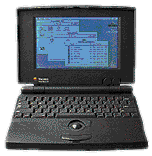Recently, I acquired my tenth Mac and my third PowerBook: a mint
PowerBook 100 from 1991. I was
really lucky, as I got it with the external floppy drive and the AC
adapter (mine says Sony on the back, not Apple, though the front has
the Apple logo!) for a mere  $20 at Goodwill Computerworks here in Austin,
TX! Those of you who have read my Mac
Obsession article on My First Mac
will recall that I was looking for a 100-series PowerBook at the time I
wrote it. Well, firstly, I found a mint PB 145B and then, two months later, this
great PB 100!
$20 at Goodwill Computerworks here in Austin,
TX! Those of you who have read my Mac
Obsession article on My First Mac
will recall that I was looking for a 100-series PowerBook at the time I
wrote it. Well, firstly, I found a mint PB 145B and then, two months later, this
great PB 100!
The PowerBook 100 is my favorite PowerBook to this day. I also have
a PowerBook 540c, which is a
really great machine, but there's just something so cool about the
100.
There are several reasons I prefer it. Firstly, there's the size and
weight. It's around 5 pounds, making it almost a full two pounds
lighter than any of the other 100-series 'Books. Plus, since it uses an
external floppy instead of an internal one, it's smaller and slimmer
than those machines, as well. The result is a sleeker looking, easier
to tote around PowerBook, which I believe was the whole idea in the
first place!
My 540c weighs like 7 pounds, which isn't super heavy - and cool
looking as the 540c is, it's far from sleek! That applies to most
PowerBooks, though. I think the only ones that truly embody the
original intent are the 100, the Duos (but they lack too many features
without the DuoDock), the 1400
(my next PowerBook!) and the 2400 (way cool machine!). The newer
PowerBooks and the iBooks are just far too weighty and big when
compared to these models.
My first Mac was also a PowerBook 100, so there's a lot of
sentimental value there for me. The 100 was also Apple's very first
PowerBook, debuting on October 21, 1991. True, it was conceived in the
pre-World Wide Web-era, as we know it, and it's lowly 68HC000 CPU and
8 MB RAM ceiling preclude any kind of modern software, but the
PowerBook 100 can still do a lot, making it a very useful Mac.
For example, it will run ClarisWorks 3.0 beautifully, a great
program for writing, painting, drawing, etc. As I write a lot, I find
CW 3.0 on the 100 perfect for that, plus the 100 is so easy to travel
with! Of course, viewing web pages is not really an option on the 100,
but it does email fine. I'm on AOL, and the 100 will only run up to AOL
2.7 (no browser), but that does allow for email, instant messaging and
chatting. I have a Global Village TelePort Platinum 19.2 kbps external
modem I take with the 100 when I travel (I must confess, for major road
trips I take my 540c, as I can access my websites and the Internet from
it). Really, the 100's forte is as a writing machine. When inspiration
hits (like right now!), it's the Mac I choose, hands down.
There's still a lot of
software that can be run on the 16 MHz PowerBook 100. Basically,
anything that will run on a Plus, Classic, SE, or Portable will run on the 100. That's
a lot of software, and it can usually be found for cheap or free! The
PowerBook 100 will run the software better than those other Macs,
too.
As far as an operating system, I find that 7.1 is best, and about as
high as one should go on the 100. It will run up to 7.5.5, but there's
a lot of stuff in there that won't work with the 100's 68HC000 CPU.
System 7.1 still does a lot, anyway, and the 100 boots in no time,
letting you get to work quickly.
So there you have it, the still stylish, still useful, sleek, and
highly inspiring PowerBook 100! It usually can be found for less than
$50, and when you realize just how cool it is, that's a steal.
Much maligned (unfairly!) in 1991-1992, this machine has stood the
test of time and become a classic Mac, just like the Mac Plus, the II-series, and the SE/30. To quote Neil Young, to my
PowerBook 100 I say long may you run!
Share your perspective on the Mac by emailing with "My Turn" as your subject.



